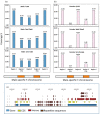The jojoba genome reveals wide divergence of the sex chromosomes in a dioecious plant
- PMID: 34570389
- PMCID: PMC9293028
- DOI: 10.1111/tpj.15509
The jojoba genome reveals wide divergence of the sex chromosomes in a dioecious plant
Abstract
Most flowering plants are hermaphrodites, but around 6% of species are dioecious, having separate male and female plants. Sex chromosomes and some sex-specific genes have been reported in plants, but the genome sequences have not been compared. We now report the genome sequence of male and female jojoba (Simmondsia chinensis) plants, revealing a very large difference in the sex chromosomes. The male genome assembly was 832 Mb and the female 822 Mb. This was explained by the large size differences in the Y chromosome (37.6 Mb) compared with the X chromosome (26.9 Mb). Relative to the X chromosome, the Y chromosome had two large insertions each of more than 5 Mb containing more than 400 genes. Many of the genes in the chromosome-specific regions were novel. These male-specific regions included many flowering-related and stress response genes. Smaller insertions found only in the X chromosome totalled 877 kb. The wide divergence of the sex chromosomes suggests a long period of adaptation to diverging sex-specific roles. Male and female plants may have evolved to accommodate factors such as differing reproductive resource allocation requirements under the stress of the desert environment in which the plants are found. The sex-determining regions accumulate genes beneficial to each sex. This has required the evolution of many more novel sex-specific genes than has been reported for other organisms. This suggest that dioecious plants provide a novel source of genes for manipulation of reproductive performance and environmental adaptation in crops.
Keywords: Simmondsia chinensis; dioecious plants; jojoba; sex chromosomes; sexual dimorphism.
© 2021 The Authors. The Plant Journal published by Society for Experimental Biology and John Wiley & Sons Ltd.
Conflict of interest statement
The authors declare no conflict of interest.
Figures



References
-
- Agrawal, V. , Sharma, K. , Gupta, S. , Kumar, R. & Prasad, M. (2007) Identification of sex in Simmondsia chinensis (Jojoba) using RAPD markers. Plant Biotechnology Reports, 1, 207–210. 10.1007/s11816-007-0031-6 - DOI
-
- Arya, D. & Khan, S. (2016) A review of Simmondsia chinensis (Jojoba)" The Desert Gold": a multipurpose oil seed crop for industrial uses. Journal of Pharmasutical Science and Research, 8(6), 381.
Publication types
MeSH terms
LinkOut - more resources
Full Text Sources
Miscellaneous

